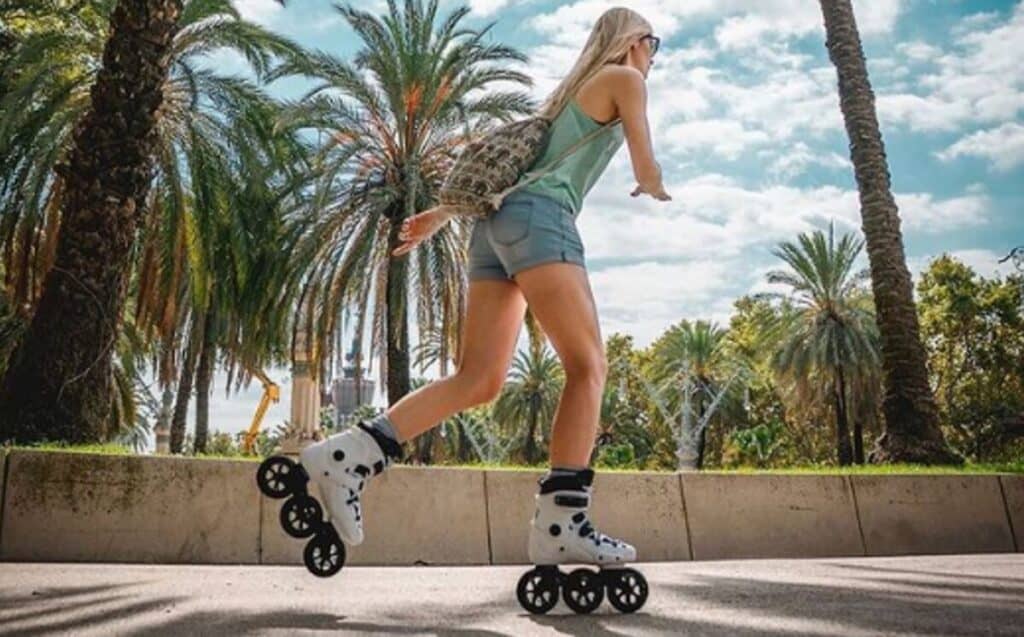
I’m about to put on inline skates and go rollerblading – what should I wear?
What clothes are suitable for rollerblading? The honest answer is you can pretty much wear what you like, some clothes are going to allow a bit more freedom of movement, so clothes like shorts and a t-shirt, but even jeans can work as long as they aren’t restrictive jeans. If you haven’t skated much before wear something you would exercise in – you might sweat a tiny bit. It’s always a good idea to wear a helmet, and wrists are the most often injured body part, so wrist guards might be a good idea too.
Let’s have a run down of some of the better clothes to wear and what’s useful
If you only have 30 seconds, this is your answer:
Wear flexible clothes that you don’t mind getting sweaty and scuffed up, especially shorts or trousers of some kind that allow plenty of movement.
Wear a helmet, and seriously consider wrist guards, and if you’re a beginner just get kitted out with knee pads and elbow pads as well to help protect your body parts when you fall.
Young children should wear a helmet, wrist guards, knee pads, and probably elbow pads too.
Do you need to wear a mask? Well, if there are not that many people around and you can keep several metres (2 and more), then you can probably get away without a mask. The key is to not skate in built up areas with lots of people close by.
Clothes To Get You Started Inline Skating
If you’re a beginner…
Ultimately you can wear what you want..
You could even get away with rollerblading in leather trousers if you wanted…
Doesn’t mean it would be easy, but you’d probably just about manage.
The important clothes choice is really what you put on your legs.
You want something that allows your legs all the range and freedom of movement you’re going to need to skate fast, and keep your balance, and go round corners, with your legs spreading out wide and your knees bending to balance.
Wear clothes that are flexible and allow plenty of movement
Shorts are a common choice for rollerblading because they allow a freedom of movement that trousers rarely do, shorts that come above the knees, but those that go below the knee are fine too. For women in summer these are a popular choice – it gives us all a chance to show off our legs as well.
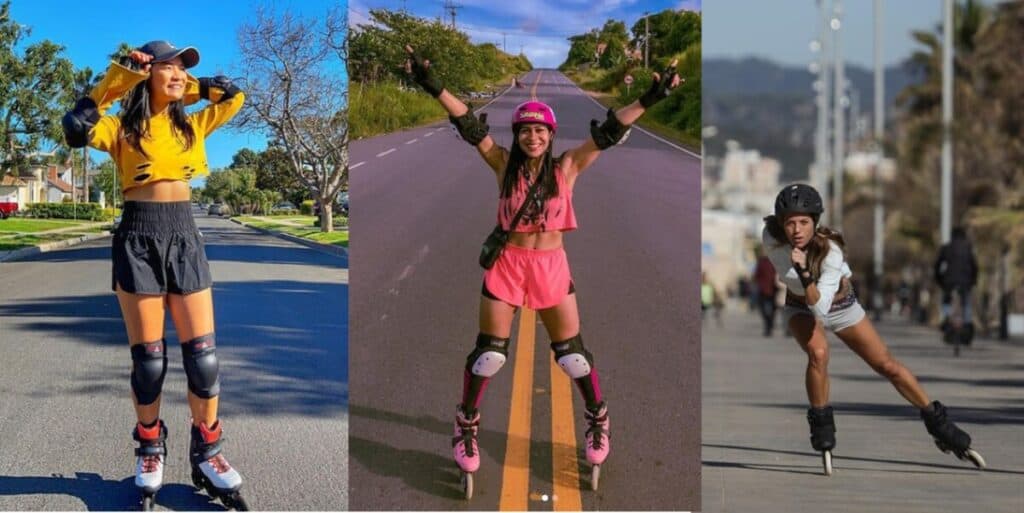
For your legs you probably actually don’t quite need the same flexibility you have if you are sprinting, because casual skating ends up with you often making smaller movements.
People do wear jeans and other trousers a lot of the time when skating. But if you’re a beginner this might not be the best option to start with.
(Usually though these aren’t skinny fit jeans or some hard material that makes it difficult to bend and flex your legs.)
You can wear a range of trousers when skating, but you will make a judgment call as to whether they allow all the movement you want.

Wear clothes that are comfortable
If you’re going to be skating for an hour or more you want to wear cothes that aren’t going to rub. Light clothes that aren’t restrictive is again the name of the game, but you can wear clothes like leggings because they’re designed to stretch easily and these don’t provide any noticeable restriction on your movement because your muscles are easily able to overcome and make them stretch.
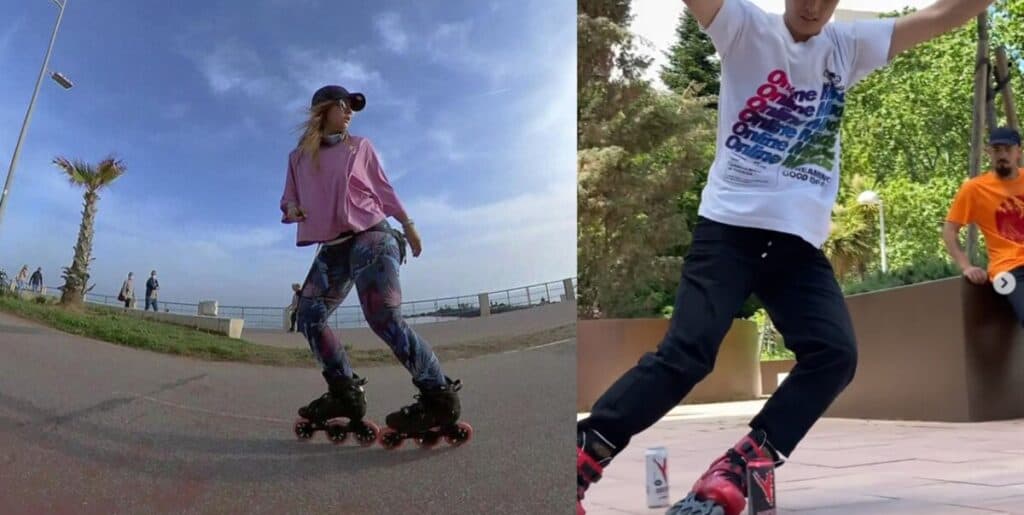
Wear a pair of socks, usually up to your ankle
You will definitely want to wear socks.
Probably normal thickness, so not super skinny socks, but regular thickness. They don’t have to be thick, as your foot might sweat a lot more than is needed and modern boots have pretty good inner socks to protect your ankles and lower shins anyway.
You don’t really want to wear those super skinny sports socks, and you will want a layer to proect your feet from sweating into the boot too much and causing the inner boot to smell.
This isn’t a huge problem for most people – just wear a normal pair of socks. Possibly on the slightly longer rather than shorter side, so they go up past your ankle.
Wear protective gear
Look, if you’ve been skating for ten years and never fallen over, and you’re only skating around your park, yes, probably you can get away without wearing any protection because you’re not going fast enough to kill yourself.
But if you’re a beginner, or doing any skating that involves even a small amount of risk, then it makes sense to wear protection of one or multiple kinds.
In short:
Wear a helmet.
Consider wearing wrist guards (most often injured area is the wrists)
Wear knee pads
Wear elbow pads
You can even get bum pads to protect you if you fall over backwards.
Do I need to wear a mask?
Air particles fly further when you are behind someone that is skating, running, or cycling because they leave a trail behind them, and because they are often breathing much more heavily than someone who is just walking. Therefore you probably want to keep a longer distance if you think there is a chance they could have covid – I mean, ideally you should go skating with people who have been vaccinated or recently tested and shown to not have the virus.
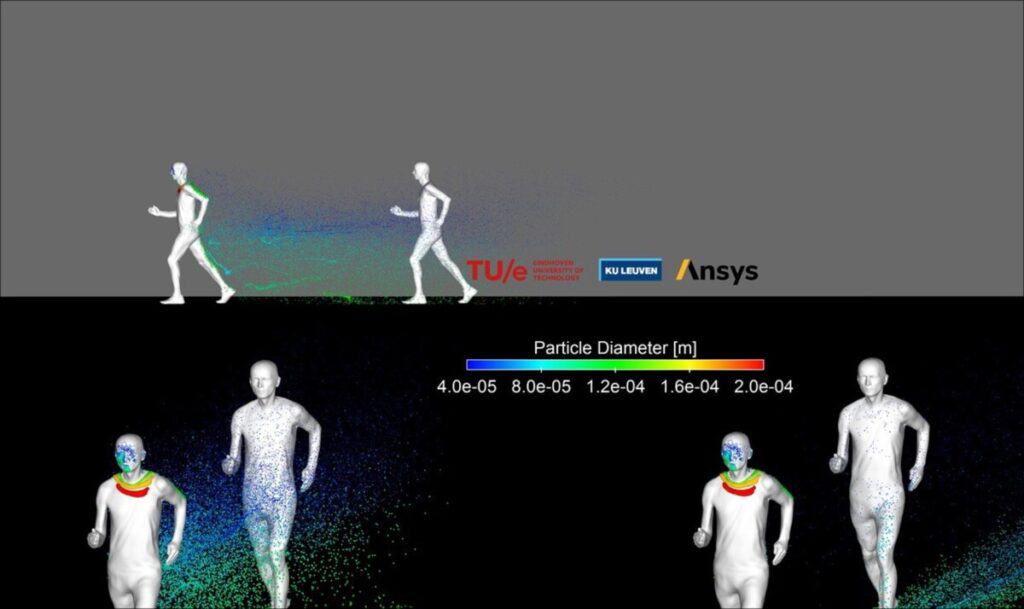
You should look at local regulations and guidance as to whether you should wear a mask.
If covid is currently high in the population and/or if you are skating in an area where there are a lot of people nearby, then it might be a good idea to wear a mask.
A mask is also about protecting others from you, as well as protecting you from them.
Probably in a lot of circumstances, as long as there is plenty of space between you and others, outside you are much more protected from covid than inside areas – the wind blows the covid particles away. Just be mindful of the research as shown in the image above that others out exercising can leave a trail of particles behind them.
Most of the time you should be fine without a mask. I go skating without a mask myself…
But if you were in incredibly built up areas, you might want to occasionally put on a mask.
Main thing is to just keep your distance…
Beginners Should Certainly Wear Protection
Age 10-14 year olds are most at risk
Young people injure themselves the most (source). In Australia, for example, 65% of injuries reported to a hospital were 5 – 14 years old (source)
Most injuries come from beginners losing control
Most injuries occur from a fall, either a loss of control, often trying to avoid an obstacle of some kind. They are more rarely the result of a collision (source), so beginners who spontaneously fall over by losing balance, or who hit a bump, crack or hole. Also, injuries also come from experienced skaters performing dangerous tricks
Most injuries occur in residential and public locations with lots of natural obstacles
They occur in residential and public locations (99%), with most injuries taking place in spring and summer as you might expect. In one study in the UK, more injuries did occur with rollerblading compared to skateboarding, probably because with a skateboard you can jump off and land on your (relatively) stable feet, whereas with skates you are stuck with the wheels attached.
These injuries affected both girls and boys equally. Although more girls under 10 years of age, and more boys over 10 years of age. (source)
A key tip is to find somewhere to skate where you might not get too many obstacles. Obstacles that get in the way include things found around backlanes, driveways, pavements, and roads.
Should I wear these items of clothing?
People wear all sorts of clothes when rollerblading
Jeans – although lots of people skate fine with jeans, children do, etc. depends really how tight. Jeans seem to be popular with the younger generation and they make it work. I know I have some tight jeans I wouldn’t skate in. Turns out the lockdown has made me fat. And the jeans, well they don’t quite stretch enough and they would certainly limit my skating.
Skin tight leggings – these are popular. There are Instagram feeds of people who wear this sort of thing. I feel like this might have been popular in the early 90s and 80s as well, so good to bring that back.
Shorts – yes certainly. But you may want to put pads on otherwise your skin is exposed to the street below.
Leather trousers? – look, you can wear leather trousers if you want. I’m not your mum. (or mom, if you’re in the US – by the way, I think you all might be spelling mum incorrectly). But it’s quite restrictive. If you are a hair metal rollerblading band, then the opposite answer applies, you must wear leather trousers, and have long curly hair.
Hoodies – yes, seem to be quite popular. Especially if cold.
Backpack – sure, lots of people wear backpacks. I do, I bring water and shoes, in case I need to change and go into a shop or if I get injured and need to walk (not happened yet, thank god)
Cargo pants – less people wear these but these used to be the thing to wear. I remember in the 90s cargo pants were all the rage and they work perfectly for ramp skating etc. though they might be a bit heavy for the exercising.
Sports bottoms – jogging bottoms – yes this works as well.
Skirts – if you want but its probably going to blow up a lot.
It depends on your skill level
If you have been rollerblading for years, and are basically a master, then this is where you get to set the terms of your own fashion.
Rollerbladers now have escaped the 90s (though see later in the article for some 90s nostalgia) and they set their own style, their style becomes a reflection of their passion for the sport and art of rollerblading. It is an expressive hobby when you get good at it, and their fashion reflects this self-expression and the freedom and artistic creativity that comes with rollerblading at a higher level.
The coolest thing is that these guys have been doing this for years, even though no one else was rollerblading until after the pandemic and everyone needed something to do, they have literally been setting trends in a pastime that they just were super passionate about. More on some examples later.
What do rollerbladers wear now?
Rollerblading is both sport, artform and to some, a lifestyle.
So people wear what they want to. What makes them feel comfortable, and if they’re into a look or styles then they wear that.
Popular rollerbladers just wear what they want, really.

Fashion reflects your age and your interests.
It also reflects your environment – you’d dress differently in a city than you might along a beach, or if you were skating in a forest (which you can, with the right type of skates).
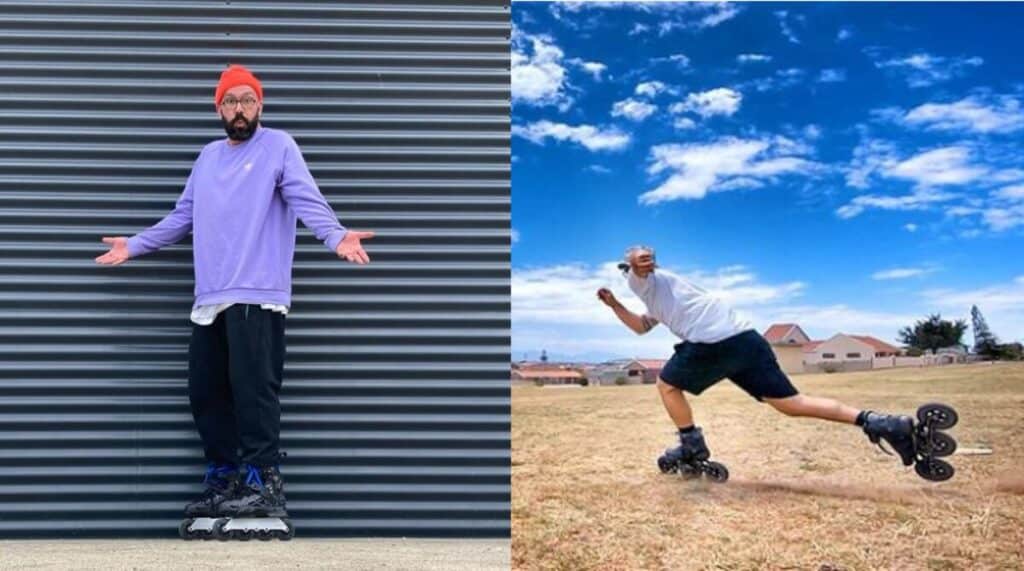
Rollerbladers who teach rollerblading for a living also might have a style they stick to – they’re rollerblading pretty must every day and it makes sense that they have a go to kit.
Some people like bright colours, others don’t. but it’s a collage out there (I just heard the word ‘collage in some music I’m listening to – so I threw that in)
Speed skaters have an actual kit.
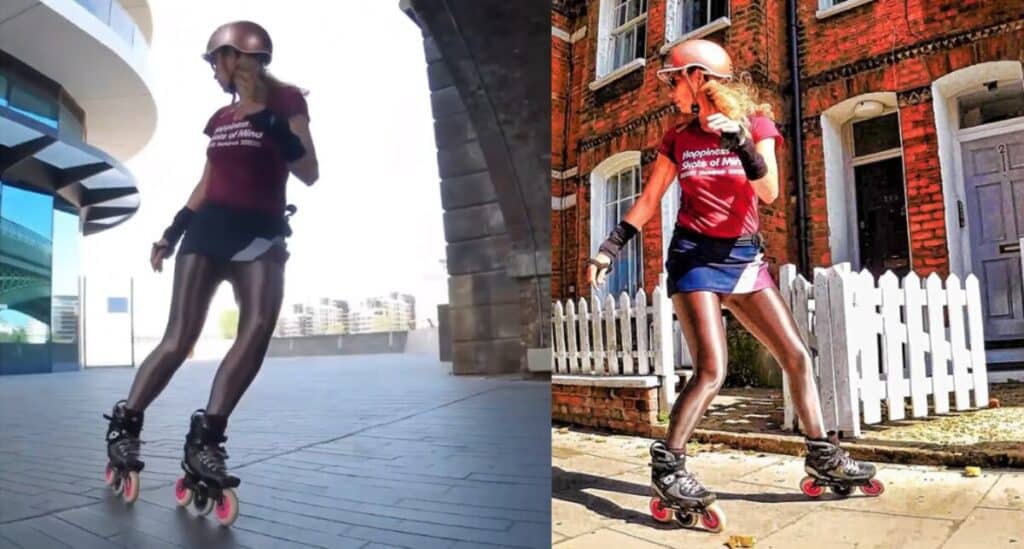
Tight lycra clothes that hug the contours of the body to provide the smoothest surface for the wind to roll over, removing as much wind resistance as is possible. Glasses to protect from flying insects and other objects, and to protect against the sun, and a performance helmet like a cycling helmet.
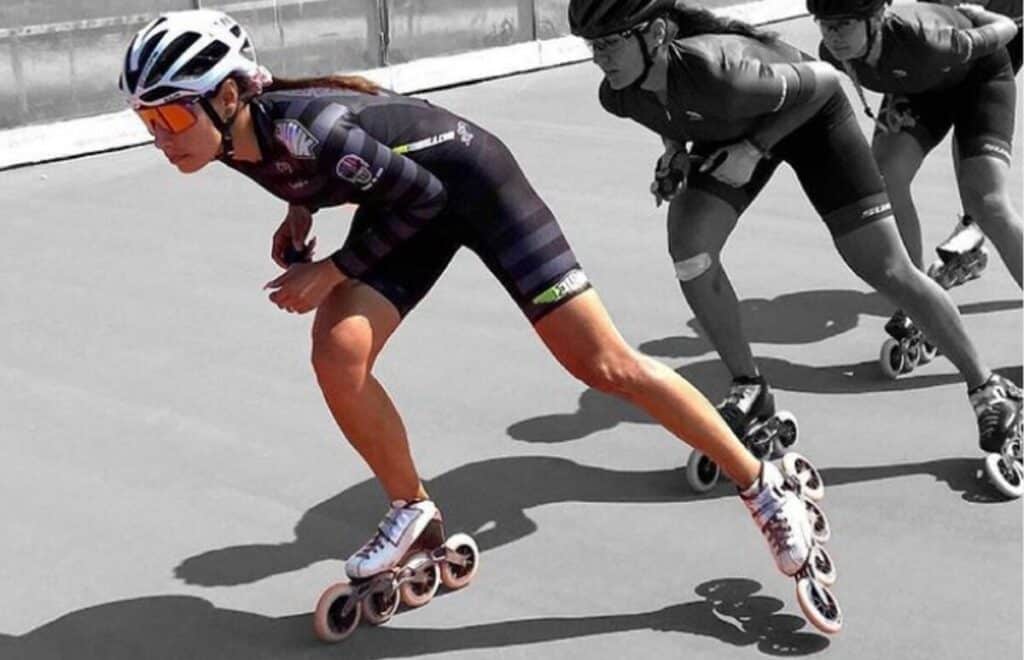
The 90s rollerblading look is no longer with us (not exactly)
The 90s look
This is what rollerblading sometimes looked like in the 90s
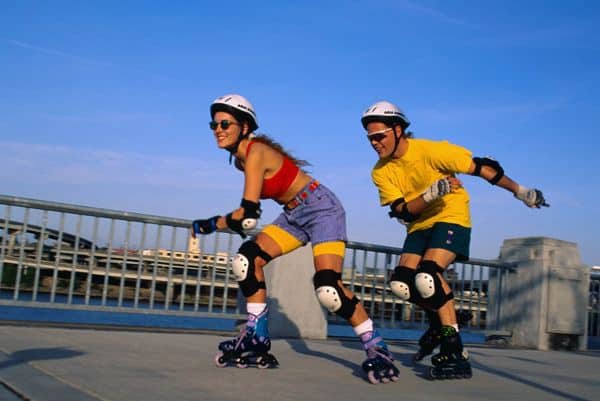
But…
The 90s are now sadly over.
Although… this brings us to the good news.
You no longer have to dress like you’re in the 90s. You can dress how you like.
Rollerblading has taken on a new style.
Now, you have films like this, that are closer to performance works of art.
This is the ZONE inline skating film, watch it in full here.
That film right there, is full on ZEN.
Articles in fancy journals need to be written about that video.
..
Is there a rollerblading look?
Not really anymore.
Perhaps back in the 90s there used to be.
Now it seems to be a lot more heterogenous. That’s your special word for the day. It means things that are dissimilar. Whereas homogenous means things that are similar.
But yeah, back to the point – people wear all sorts of different fashion when they skate.
…
Do I need to wear a helmet? It’s a good idea to wear a helmet if there’s any chance that you’re going to fall over. And if you’re a complete beginner and/or haven’t skated for a while, then it makes sense to wear a helmet. Especially if you’re going to be skating anywhere with natural obstacles.
Can I wear jeans? If you want, but if these are tight jeans they’re unlikely to provide as much flexibility for skating faster. Again, if you’re a beginner you might want to go with something a bit more flexible to help you learn the necessary balance first.
